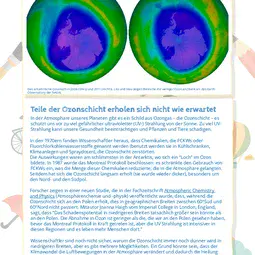Parts of ozone layer not recovering as expected
6 February 2018
In the atmosphere of our planet, there is a shield of ozone gas – the ozone layer – that protects us from receiving too much dangerous ultraviolet (UV) radiation from the Sun. Too much UV can affect our health and also damage plants and animals. In the 1970s, scientists discovered that chemicals called CFCs or chlorofluorocarbons (used in fridges, air conditioners and aerosol sprays) were destroying the ozone layer. The effect was worst in the Antarctic where an ozone ‘hole’ formed. In 1987 the Montreal Protocol was agreed; this phased-out the use of CFCs, which reduced the amount of these chemicals reaching the atmosphere. Since then, the ozone layer has been slowly recovering (getting thicker), especially around the north and south poles. In a new study published in Atmospheric Chemistry and Physics, researchers revealed that while the ozone layer is recovering at the poles, this is not happening at latitudes between about 60°S and 60°N. Co-author Joanna Haigh, from Imperial College London in the UK states that “The potential for harm in lower latitudes may actually be worse than at the poles. The decreases in ozone are less than we saw at the poles before the Montreal Protocol was enacted, but UV radiation is more intense in these regions and more people live there.” Scientists are not yet sure why the ozone layer is still getting thinner in the lower latitudes, although there are a few possibilities. One reason could be that climate change may be changing the way air moves in the atmosphere, slowing the recovery of the ozone layer. Another explanation is the increase in emissions of a few ozone-destroying chemicals that were not included in the Montreal Protocol (see the ‘New threat to the ozone layer’ Planet Press). While there is no immediate cause for alarm (though you should always be careful to wear sunscreen), the study is a warning for governments to keep looking after our precious ozone layer.Find out more
Discuss with your teacher or parents
How high-up in the atmosphere is the ozone layer? What is the name of the region where it is located?
What are CFCs, also known as chlorofluorocarbons? How can they affect the ozone layer?
What is latitude? And longitude? Can you name countries that are between latitude 60°S and 60°N?
Find out more at egu.eu/42M8YE.
Print version

This is a kids' version of the EGU article: 'Parts of ozone layer not recovering as expected'. It was written by Bárbara Ferreira (EGU Media and Communications Manager), reviewed for scientific content by Kirsty Pringle & Richard Pope (Research Fellows, Institute for Climate and Atmospheric Science, University of Leeds, UK), and for educational content by Teresita Gravina (Italian Association of Science Teachers [ANISN]).
Translations










All English-language Planet Press releases are carefully edited, reviewed and proofed, by scientists, educators and EGU staff. Please note that once translated, Planet Press releases receive no further checks from EGU staff. For this reason, we cannot guarantee their accuracy, though we trust the quality of our voluntary translators and are grateful for their work.

